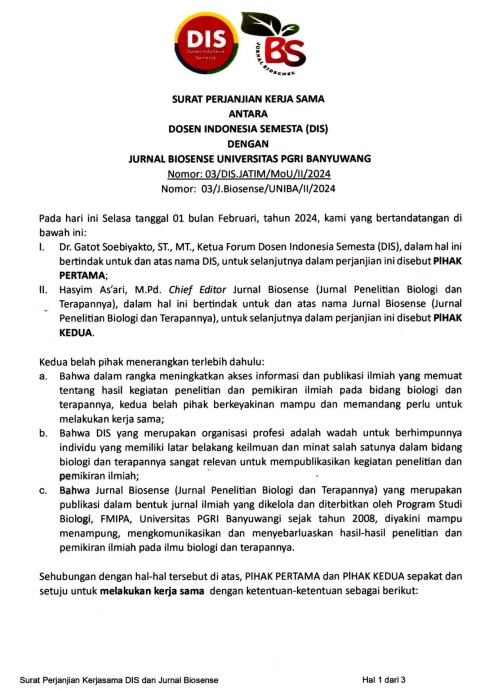KEANEKARAGAMAN DAN POLA DISTRIBUSI BIVALVIA DI TELUK PANGPANG BLOK JATI PAPAK TAMAN NASIONAL ALAS PURWO BANYUWANGI
DOI:
https://doi.org/10.36526/biosense.v7i01.3850Keywords:
bivalves, diversity, distribution patternsAbstract
Alas Purwo National Park in Banyuwangi is one of the conservation areas of mangrove forest potential big enough one of them is the Teluk Pangpang Blok Jati Papak which is the intertidal area, a lot of marine life that live in the region one of which is the bivalves. This study aims to determine diversity and the distribution pattern of bivalves in the Teluk Pangpang Blok Jati Papak. This study was conducted in 25 Mei - June 1, 2016. Determination of the sampling method used in this research is purposive sampling. Sampling sites are divided into three stations, with the distance between stations is 500 m, in each station there are four transects on each transect contained 10 plot. set the distance between transects 15 m and the distance between the plots 5 m with a plot measuring 2 × 2m. Measurement parameters abiotic do is measure temperature, salinity and pH. The research found 8 species of bivalves that Anomalodiscus squamosus, Placamen chlorotica, Pitar citrus, Chamelea gillina, Mactra grandis, Hiatula chinensis, Tellina timorensis, Anadara granosa. An index value of diversity bivalves in the Teluk Pangpang Blok Jati Papak categorized as low, with the highest index value at station 1 at 0.766 and the lowest at station 2 by 0.66. Biavalvia distribution patterns in the region are random in species Anomalodiscus squamosus, Pitar citrus, Chamelea gillina, Mactra grandis, Hiatula chinensis, Tellina timorensis, Anadara granosa and are clustered in Placamen chlorotica species.
References
Barnes, R.D. & E.E Ruppet. 1994. Invertebrata Zoology. Sixth Edition. United States of America. P.460.
Brower, J.S., J.H. Zar. 1998. Field and Laboratory Methods for General Ecology. Third Edition. Brown.
Brower, J.Z. Jerrold, C. Von Ende. 1990. Field and Laboratory Methods for General Zoology. Third Edition. United states of America: W.M.C Brown Publisher. America. P 160-162.
Campbell, J. B. Reece, L. G dan Mitchell. 2004. Biologi. Edisi Kelima. Jilid 3. Jakarta. Penerbit. Erlangga.
Dharma, B. 1988. Siput dan Kerang Indonesia I. PT. Sarana Graha. Jakarta.
Dharma, B. 1992. Siput dan Kerang Indonesia II. PT. Sarana Graha. Jakarta.
Dinas Perkebunan dan Kehutanan Banyuwangi. 2003. Laporan Tahunan. Dinas Perkebunan dan Kehutan. Banyuwangi.
Fachrul, F.M. 2007. Metode Sampling Bioekologi. Bumi Aksara. Jakarta.
Heddy, S. 1994. Prinsip-prinsip Dasar ekologi. Raja Grafindo Persada. Jakarta. Hlm. 271.
Hickman, P.C. 1996. Integrated Principles of Zoology. Third Edition, America. United States of America. P. 356-358.
J.S. 1982. Imerine Ecology: prentice Hall, Inc. America. P. 235-269.
Kementrian Kehutanan. 2006. Kawasan Konservasi. Banyuwangi
Michael, P. 1994. Metode Ekologi untuk Penyelidikan Lapangan dan Laboratorium. Alih Bahasa : Y.R Kostoer. Universitas Indonesia Press. Hlm 195.
Newell, N. D. 1969. Treatise on invertebrata Paleontology. In Moore, R.C.
Nontji, A. 1987. Laut Nusantara. Djambatan. Jakarta.
Nontji, A. 1993. Laut Nusantara: Djambatan. Jakarta.
Nontji, A. 2007. Laut Nusantara. Djambatan. Jakarta.
Nurdin, J., Supriatna, J., Patria, M.P. dan Budiman. A. 2008. The Potential Edible Bivalvia and its Diversity In The Coastal Waters of South Kabung Bay. Wes Sumatra : With Special Case Of Gafrarium Tomidum.
Nyabakken, J.W. 1992. Biologi Laut: Suatu Pendekatan ekologis. Alih Bahasa Oleh: H.M Eidman Jakarta: PT. Gramedia. Hlm. 367.
Odum, E.P. 1998. Dasar-dasar Ekologi. Edisi Keempat. Alih Bahasa Oleh T. jahjono. FMIPA. IPB> Gadjah Mada University press. Yogyakarta. Hlm. 370-375.
Odum, Eugene. 1993. Basic Ekolgy. Japan: Saudes Collage Publishing.
Pemkab Banyuwangi. 2014. Letak Geografis Daerah. Banyuwangi.
Peraturan Pemerintah No. 82 tahun 2001. Banyuwangi.
Prawirohartono, S. 1994. Pengantar Ekologi. Remaja Karya. Bandung. Hlm. 174.
Printrakoan and Temkin, I. 2008. Comparative Ecology of Two Parapatric Population of Isognomon (Bivalvia = Isognomonidae) of Kungkrabaen Bay, Thailand. The Raffles Bullettin of Zoology. Supplement No. 18: 75-94.
Romimohtarto, K. 1985. Kualitas Air dalam Budidaya Laut WBL/05/WP-13 Bandar Lampung 28 Oktober-1 November 1985.
Sastrawijaya, A.T. 1991. Pencemaran Lingkungan. PT. Rineka Cipta. Jakarta. Hlm. 83-87.
Setiadi, D dan P.D Tjondronegoro. 1989. Dasar-dasar Ekologi. Departemen Pendidikan dan Kebudayaan Direktorat Jendral Pendidikan Tinggi Pusat Antar Universitas Ilmu Hayati. IPB. Bogor.
Soegianto, A. Ir. 1994. Ekologi Kuantitatif Metode Analisis Populasi Komunitas. Penerbit Usaha Nasional Surabaya.
Stowe, K. 1987. Essentials of Ocean Secience. John Wiley and Sons. Kanada. P. 353.
Sugiri, N. 1989. Zoologi Avertebrata II. IPB. Bogor. Hlm 57-65
Suin. 1989. Ekologi Hewan Tanah. Bumi Aksara. Jakarta. Hlm 49.
Sumich, C.L. 1992. Marina Life. Fifth Edition. Wm. C. Browen Publisher. United States of America. P. 17, 225-236.
Surat Keputusan Menteri Lingkungan Hidup No. 51 Tahun 2004. Tentang Baku Mutu Air Laut.
Suryanto dan Utojo. 2002. Pertumbuhan Tiram pada Penyebaran yang Berbeda-beda. Jurnal Penelitian Budidaya Pantai.
Suwignyo, S. 2005. Avertebrata Air. Jilid 1. Penerbit Penebar Swadaya. Jakarta. Hlm. 122.
Tarumingkeng, R.C. 1994. Dinamika Populasi: Kajian Ekologi Kuantitatif. Pustaka Sinar Harapan dan Universitas Kristen Krida Wacana. Jakarta.
Undang-undang Nomor 5 Tahun 1990. Tentang Konservasi Sumberdaya Alam Hayati dan Ekosistemnya. Jakarta.
Warwick, R. M. 1993. Enviromental Impact Studies on Marine. Australian Journal of Ecology. Vol 18, 63-80.
Weisz, P.B. 1973. The Secience of Zoology. Second Edition. MC. Graw-Hell, Inc, United States of America. P. 125.
Winanto, T. 2004. Memproduksi Benih Tiram Mutiara. Cetakan 1. Penerbit Penebar Swadaya. Jakarta. Hlm. 17-24.

















